Adrian Kay - overseeing trackworks at York Racecourse
 With Adrian's arrival, plans were put in to place to secure funding and the necessary planning permissions to undertake a complete overhaul of the course. This was known as the York Trackworks Project
With Adrian's arrival, plans were put in to place to secure funding and the necessary planning permissions to undertake a complete overhaul of the course. This was known as the York Trackworks Project
I always enjoy revisiting places to see what has been achieved since the last time. My first visit to York Racecourse was back in 2006, shortly after Adrian Kay had been appointed as Head Groundsman, followed by a 'day at the races' in 2008.
Adrian had been putting new maintenance regimes in place to help improve the course and its presentation, which required the purchasing of new machinery and changing the way the course itself was maintained.
The commitment of the York Board and its Chief Executive and Clerk of the Course, William Derby, to the racing surface meant that, if Adrian could make the case for new kit, then they were prepared to back his recommendations. So, his first acquisition was a John Deere 1600T wide area mower, primarily for use on the racetrack and other large grass areas such as those used for car parking.
 This was followed by a Charterhouse 7526 vertidrain, a Charterhouse 2075 2.0 metre disc seeder, and a John Deere HPX utility vehicle for getting around the site, providing a faster and lighter footprint, without the need to use a tractor and trailer for all operations.
This was followed by a Charterhouse 7526 vertidrain, a Charterhouse 2075 2.0 metre disc seeder, and a John Deere HPX utility vehicle for getting around the site, providing a faster and lighter footprint, without the need to use a tractor and trailer for all operations.
He also purchased a tractor mounted Kuhn fertiliser spreader to speed up the efficiency of the task, a 7 metre boom sprayer for a flexible approach to applying fertilisers, and ride-on John Deere 2653A triple mowers to enhance the quality of the lawn areas throughout the site.
Adrian is a stickler for presentation, and his new purchases, along with extolling the virtues of his working methods to his team, reaped immediate rewards, with both racegoers and his paymasters commenting on how the whole site had improved.
However, these improvements would only be short-term; what was really needed was some serious investment to make a step change in the performance of the course, and so help it stay as a destination for the best of thoroughbreds and their connections, who set demanding twenty-first century standards.

The profile of York Racecourse was raised significantly when it played host to Royal Ascot at York in 2005 and the Ladbrokes St Leger in 2006, whilst Ascot and Doncaster, respectively, underwent grandstand developments.
York has a strong record of investment, not only in prize money, but also a succession of new stands in the past twenty years that have improved the race going experience. In addition, stable blocks, stable lad accommodation and the Parade Ring have all benefitted from upgrades, and 2004 saw the completion of a new north bend. Yet, the track itself had not had any major work carried out. The threat of abandonment due to waterlogging hangs heavy on every racecourse, with its resultant commercial cost, and many in the ranks of trainers are loathe to run their charges when they consider a track to be too firm or, indeed, too soft.
So, with Adrian's arrival, plans were put in to place to secure funding and the necessary planning permissions to undertake a complete overhaul of the course. This was known as the York Trackworks Project.
 Working with the experience of William and his own team, as well as key external consultants, Adrian planned several major works on the basis that they could achieve the following objectives:
Working with the experience of William and his own team, as well as key external consultants, Adrian planned several major works on the basis that they could achieve the following objectives:
- to be better able to manage the racing surface in climate extremes and climate change
- help provide a more consistent racing surface throughout the season
- provide a service road alongside the track for various uses (such as by his team, so limiting wear on the track itself), or by local joggers and the chase vehicles during racing
- increase options to provide fresh ground through the season
- remove the anti-camber on the south bend
To achieve these aims, the following planned works were implemented:
- a new intensive drainage system throughout the course
- a new, up-to-date irrigation system
- the building of a 3.5m tarmac service road
- the construction of a 10m south bend extension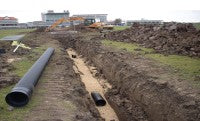
- re-grading of surface levels on the existing south bend
- the construction of a canterdown
A team of experts were assembled to help complete the project, with Adrian being one of the lead members and acting as coordinator. This saw a three year programme which began with the installation of a new complete drainage scheme - the building of several main carrier drains, installing over 3,000 linear metres of main drains inside the running rail, and in excess of 18,000 metres of lateral drains installed at five metre centres.
Over 80,000 metres of drainage slits, at one metre centres, were then inserted over the primary lateral drains to complete the system.
Having an extensive drainage system, not only meant that the track would drain quickly, but it would also dry quicker and, so, to ensure the track could be watered more efficiently, thereby maintaining the optimum going, a new pop-up irrigation system was installed.
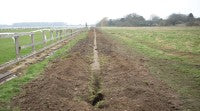
This incorporated a new pumping station with large pumps, and a borehole into the natural sandstone aquifer (90 metres deep), a holding tank with a capacity of 200 cubic metres, and a complete set of over 350 new Rainbird sprinkler heads set on both sides of the track. This was backed up with two Briggs overhead boom irrigators. This new system also had the latest Rain Bird Site Control IT management systems to collate and control the amount of water applied. The new borehole provides up to 6.3million gallons of sustainable water, annually, that can be used to irrigate the course and lawns. It is literally rainwater that fell before the Romans were custodians of the city which is used on the track.
Adrian was also keen to improve the water quality, so he had a Quadrop injection system built into the pump house that injects 270ml of concentrate of mineral acids into 1,000 litres of water. Quadrop is designed to improve the water quality, simulating natural rain. The sulphuric acid levels also help maintain soil pH levels and control the quantities of carbonates and bi-carbonates, whilst also giving it some wetting agent properties. This system is already i n use at other sporting venues, with results being very favourable.
n use at other sporting venues, with results being very favourable.
Having a fully controllable irrigation system has helped improve the sward quality at York, and Adrian has more control over the going, being able to give precise watering to specific parts of the course.
Running in conjunction with the drainage work was the building of the new service road and canterdown. The service road is particularly important during racedays, acting as a thoroughfare for vets, starters, groundstaff and ambulances.
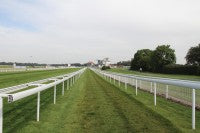 The canterdown is specifically used as a bridleway to the starts, thereby keeping horses off the racing surface. And, finally, there was the work to widen parts of the track to give the option of providing new ground during race meetings, this came in the shape of a 10 metre extension to the south bend from the nine furlong through to the four furlong marker.
The canterdown is specifically used as a bridleway to the starts, thereby keeping horses off the racing surface. And, finally, there was the work to widen parts of the track to give the option of providing new ground during race meetings, this came in the shape of a 10 metre extension to the south bend from the nine furlong through to the four furlong marker.
I visited Adrian during the week of the Welcome to Yorkshire Ebor Festival, one of the biggest meetings of the British flat season, with over 93,000 people due to attend over the four days.
The day begins very early, around 5.30am, when Adrian, William and Assistant Clerk of the Course, Anthea Morshead, all walk the course to enable them to declare the going. With just over two miles in circumference to cover and 20m in width, this takes about an hour.
The going is checked both electronically and manually, and the TurfTrax electronic Going Stick is used to measure the condition of the turf at over sixty points around  the course. Three measurements are taken at each point, with the average of the three scores recorded to produce a map of the going.
the course. Three measurements are taken at each point, with the average of the three scores recorded to produce a map of the going.
On the day of my visit, the going was declared good to soft with an average score of 6.1.
The reason the going is declared so early is to notify the trainers, so they can decide if they want to run their horses. The going will also be checked prior to the first race. It allows Adrian to keep an eye on the condition of the course.
Adrian manages a permanent staff of seven, although he recently lost his assistant of the last five years, John Morley, who has moved to take up the Head Groundsman position at nearby Beverley Racecourse. Kevin Upton has been promoted to Assistant Head Groundsman. He is no stranger to York, having worked there for seventeen years.
Other members of the team are Ian Halstead, Paul Harris, Neil Rankeillor, John Imeson, Tom Maloney, Mick O'Leary, John Dinsdale and John Crowe.
Ian Halstead has been at York for forty-six years. His main job is to look after all the gardens, lawns, hanging baskets, troughs and tubs. He selects and grows all the 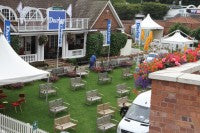 spring and summer bedding material himself, and has to grow enough to fill over one thousand planters, baskets and tubs. During the summer months, much of his time is taken up watering all these plants. Just as we go to press, we have learned that the judges for the prestigious Yorkshire in Bloom Awards have announced York as a two time winner; the track scooped a highly prized Gold Rose Award for its many floral displays, whilst Ian gets his name engraved on the prestigious Sawley Arms Trophy, as the individual who has done the most to promote Yorkshire in Bloom.
spring and summer bedding material himself, and has to grow enough to fill over one thousand planters, baskets and tubs. During the summer months, much of his time is taken up watering all these plants. Just as we go to press, we have learned that the judges for the prestigious Yorkshire in Bloom Awards have announced York as a two time winner; the track scooped a highly prized Gold Rose Award for its many floral displays, whilst Ian gets his name engraved on the prestigious Sawley Arms Trophy, as the individual who has done the most to promote Yorkshire in Bloom.
After the early morning course inspection, it is a case of putting the final touches to the course in readiness for the days racing. Kevin jumps on the Toro 5900 Groundsmaster mower (a recent purchase) to complete the mowing of the home and back straights. I catch a lift with Adrian to meet up with the divot team, who are busy repairing the damage from the previous day's racing. This is a team of thirty who go around the course backfilling any damage made by the horses, filling in holes with a 60/40 rootzone material with a blend of rye grass and slender creeping red fescue grass seed. Adrian will use around twenty tonnes after every meeting.
The track is mown every second or third day to a height of 100mm. A feeding programme is implemented to keep the sward in good condition, using seaweeds, NPK 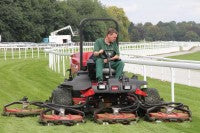 fertilisers, organic products and trace elements. These have included 25:5:10, 11:1:5 and 15:0:10 granular and liquid feed. Wetting agents are also used, along with Quadrop injections.
fertilisers, organic products and trace elements. These have included 25:5:10, 11:1:5 and 15:0:10 granular and liquid feed. Wetting agents are also used, along with Quadrop injections.
The aim is to produce a strong dense turf with deep rooting to withstand the rigours of horseracing whilst, at the same time, producing a consistent going. Aeration is also a key operation to maintaining porosity in the track, being vertidrained several times throughout the year.
The rest of the morning was spent inspecting other parts of the course and checking everything was in order - running rails, crossing points and starting chutes. We then met up with Anthea, once again, on the back straight. As the off approaches, the Assistant Clerk wanted to do a final check on the going after a morning of Yorkshire summer, and she confirms the going as still good to soft.
Adrian then took me to see more of his handy work. He has been refurbishing several lawn areas, which saw their complete renovation, digging out 300mm depth of  old material, installing primary drains, refilling with 300mm of 70/30 rootzone materials, and covering with new turf. They are now able to cope with the large amount of foot traffic, look aesthetically better and drain very well. The work has been so successful that Adrian intends to renovate the parade ring next year, using the same techniques.
old material, installing primary drains, refilling with 300mm of 70/30 rootzone materials, and covering with new turf. They are now able to cope with the large amount of foot traffic, look aesthetically better and drain very well. The work has been so successful that Adrian intends to renovate the parade ring next year, using the same techniques.
After lunch (sandwich sat in the pick-up), Adrian took over from Kevin to finish off the mowing.
Racing was due to start at 2.00pm so, for the last hour, it was final checks ensuring all his staff are in their appropriate places around the track. All staff are equipped with mobiles and hand-held radios, so that they can report any problems immediately, as there is little time between races.
To open the event, a team of RAF parachutists dropped in and Adrian and I had a bird's eye view; watching fifteen parachutists landing one after the other 'onto a sixpence' was a spectacular sight.
Within ten minutes of them landing, the first race was underway; one of six scheduled for the day.
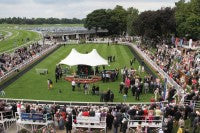 We met up with William Derby in the winner's enclosure; he was very pleased with how the day was progressing, and the weather was being kind, with plenty of sunshine. Everywhere was busy, with over 28,000 customers enjoying the Ladies Day experience. Over the four days of the Festival, the track would see a record number of runners, with 347 horses chasing the £2.8million in prize money.
We met up with William Derby in the winner's enclosure; he was very pleased with how the day was progressing, and the weather was being kind, with plenty of sunshine. Everywhere was busy, with over 28,000 customers enjoying the Ladies Day experience. Over the four days of the Festival, the track would see a record number of runners, with 347 horses chasing the £2.8million in prize money.
I stayed for a couple more races, prior to heading for home before the last race, enabling me to beat the traffic. As for Adrian and his staff, there was no going home until they had finished moving the running rail to provide fresh ground for the next day's action. This involves moving several furlongs of fencing which takes about four hours to complete, so Adrian and his team don't finish much before 10.00pm.
The hours are long but, as Adrian says, it is all worthwhile. It is what groundsmanship is all about - the trials, tribulations and rewards for producing top class facilities.
Adrian is pleased with what he has achieved during the last five years, and says that working with the likes of William and Anthea, whilst leading his dedicated team, remains a privilege. That the York Board had the foresight and commitment to support such a large project is commendable. It has been a great team effort from all concerned.
